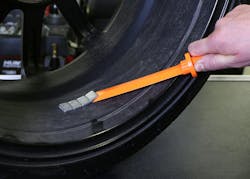Installing high performance (HP) and ultra-high performance (UHP) tire and wheel combinations presents unique challenges in maintaining proper wheel balance.
“The correct selection and application of wheel weights is essential for safety, performance and aesthetics,” says Eric Dienethal, product manager, Wegmann Automotive. “Technicians working with high-diameter and performance wheel combinations must consider various factors to achieve optimal balance.”
Using high-quality wheel weights is critical to achieving correct balance for HP/UHP and custom wheel combinations.
“Inferior adhesives or low-quality, improperly fitted, clip-on wheel weights can detach under spirited driving conditions — leading to excessive vibrations, reduced handling precision, premature tire wear, and safety hazards,” says Dienethal. “The right choice in wheel weights ensures the long-term performance and safety of both the wheel and tire package.”
The choice of material for wheel weights is another important consideration, according to Dienethal. “Lead, zinc and steel weights are common options and technicians must ensure compliance with local regulations. Zinc remains the OEM-preferred option for clip-on weights, ensuring a secure and corrosion-resistant fit.
“For adhesive weights, high performance domestic tapes deliver superior bonding strength and reliability under demanding conditions. Cold-weather and UltraLiner adhesives ensure performance across temperature extremes, maintaining adhesion where lower-quality import tapes fail.
“If using clip-on weights, verifying the correct clip profile with a lip-flange tool before installation is important to ensure a secure fit without gaps. Selecting the appropriate weight size, shape and color helps maintain both balance and aesthetic appeal.”
Keep it clean
Cleaning the wheel surface before applying wheel weights is an essential practice to help ensure a secure bond, according to Dienethal.
“Installing the adhesive weights firmly prevents detachment at high speeds or under temperature fluctuations,” he notes, adding that “most all balancing machines allow technicians to detect and correct imbalances accurately.
“It should also be mentioned that reusing old weights or stacking multiple adhesive weights on top of each other — or combining smaller clip-on weights to match a required weight — must be avoided. Instead, always use a single adhesive strip or clip-on weight that is properly sized for the imbalance.
“Selecting and applying the right wheel weights is essential for balancing aftermarket tire and rim packages. By following industry best practices and considering aesthetic concerns, technicians can enhance vehicle performance, ensure driver comfort, maintain a professional finish and most importantly, provide a consistent and safe driving experience. Proper wheel balance improves handling, increases tire longevity and provides a smoother ride.”
About the Author
Mike Manges
Editor
Mike Manges is Modern Tire Dealer’s editor. A 28-year tire industry veteran, he is a three-time International Automotive Media Association Award winner, holds a Gold Award from the Association of Automotive Publication Editors and was named a finalist for the prestigious Jesse H. Neal Award, the Pulitzer Prize of business-to-business media, in 2024. He also was named Endeavor Business Media's Editor of the Year in 2024. Mike has traveled the world in pursuit of stories that will help independent tire dealers move their businesses forward. Before rejoining MTD in 2019, he held corporate communications positions at two Fortune 500 companies and served as MTD’s senior editor from 2000 to 2010.


